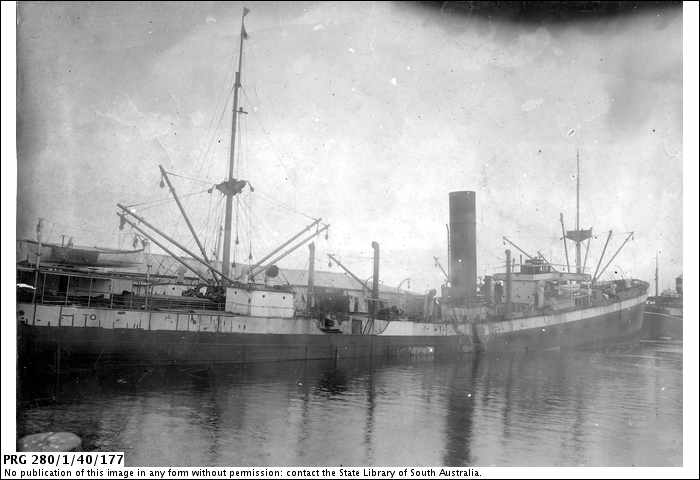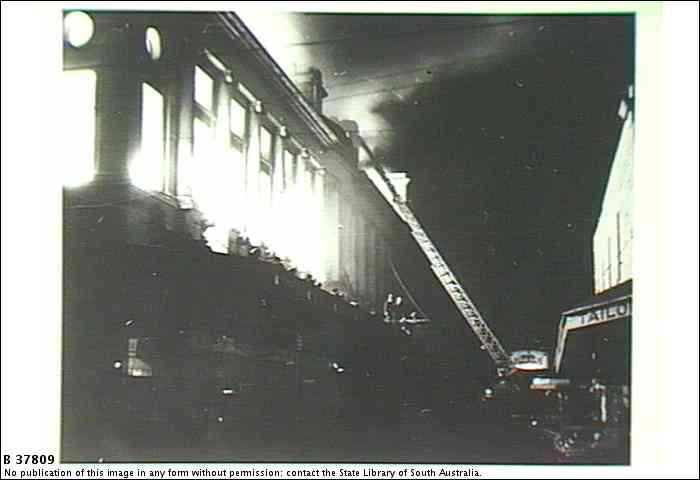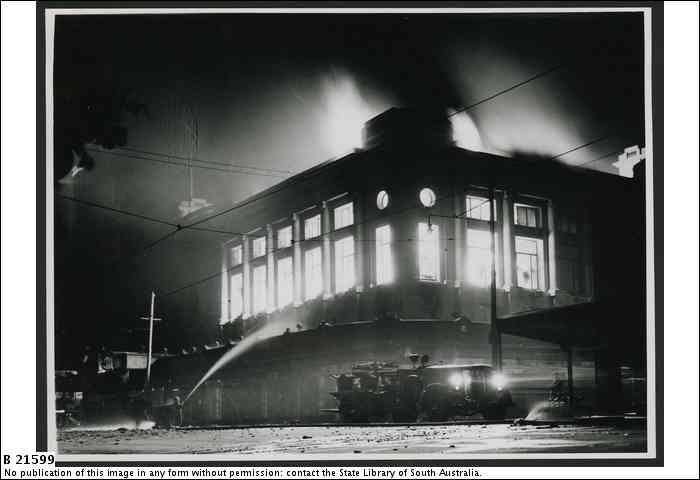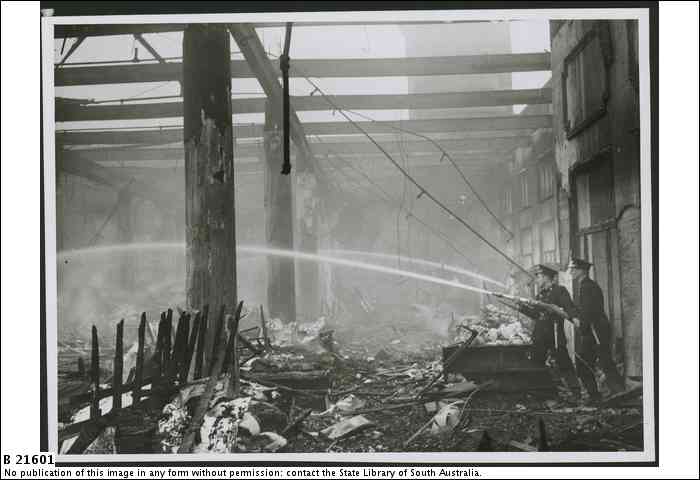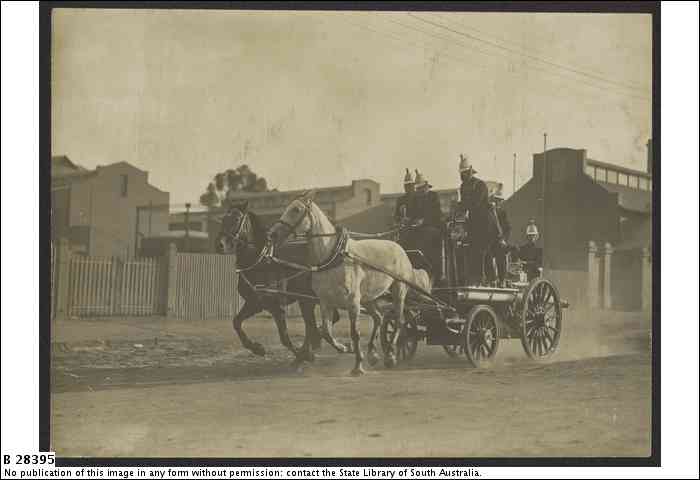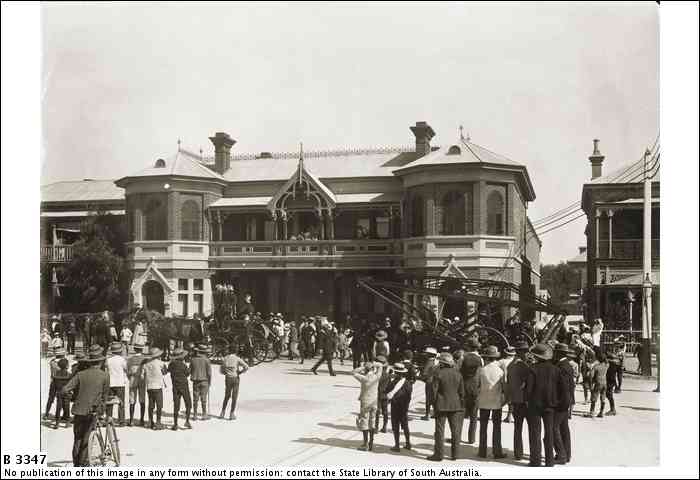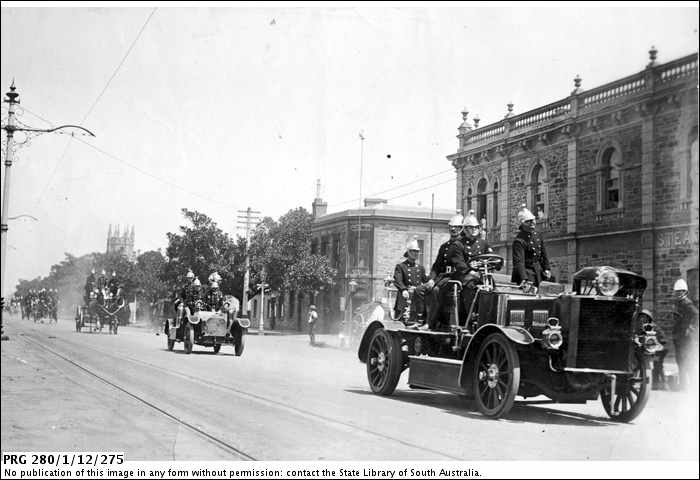Suggest a topic
Suggest a new Did you know? topic

Fires in Adelaide
891 ABC Afternoon Delights at the State Library : 25 October 2005
Carole Whitelock talks with Michael Talbot
I was in Elder Park recently. Seeing the memorial to Fireman Gardner made me think of some of the fires there have been in Adelaide.
Christmas Eve 1886
Fires were not uncommon. When the building housing the Academy of Music in Rundle Street caught fire on Christmas Eve 1886, it was the third time in three years it had been fire-damaged. The 1886 fire was said to have caused damage worth ₤60,000 to the academy, a billiard saloon and several shops. It was not the largest at the time, but the first to claim the lives of fire-fighters.
It is a reminder how easily and quickly a small occurrence can get out of hand. Some lace in the window of Castle's shop came in contact with a gas jet that lit the window. Instead of pulling the lace down and trampling it, the nearest person went some distance to raise the alarm. It was ten minutes before the fire brigade arrived because no-one thought to summon them using one of a number of telephones in the vicinity.
The roof of Cunningham's shop crashed in trapping firemen Clark and Gardner. Clark was pulled clear. He was injured, but able to walk. He was taken to a nearby hotel and then to hospital, but he died from his injuries.
A dozen people, working by the light of a small lantern, searched for Gardner until about 1.30 on Christmas morning. Burning gas forced them to stop at intervals. Walls threatening to collapse halted the search. At daylight, demolition equipment and workers were brought in from the Bank of New South Wales building site. After the walls were pulled down a search party resumed work and found Gardner's body about 2.30 on Christmas afternoon.
Clark was buried on 26 December and Gardner the next day. The newspapers reported large funeral processions for both. Gardners' funeral was at the Mitcham Cemetary. His procession included the Police Band, Mounted Police, Foot Police, Mourning Coaches, Fire Brigades, Fire Brigades Board, Naval and Military Forces, and Volunteers. It left from the fire station which was then in Flinders Street. It went along Pulteney Street, Rundle Street past the scene of the fire, then along King William Street and Unley Road. Gardner's friends had asked for the funeral to be as private as possible so as it neared the Mitcham Cemetery the police, firemen, etc left and the funeral took on a private nature.
Clark's friends met very soon afterwards and raised money for a memorial to be placed at his grave. It took longer for a group to come forward to support Gardner, but enough money was raised for a headstone and a drinking fountain and a full length painting presented to the Adelaide Fire Brigade. First suggestions were for the drinking fountain to go in the Botanic Park or Gardens but this was changed to Elder Park.
Gardners' memorial cost ₤100 and was described as chaste Gothic design. The canopy weighs 3 tons is white Kapunda marble. The bases are of West Island granite and the supporting columns are blue Kapunda marble.
Firefighting equipment
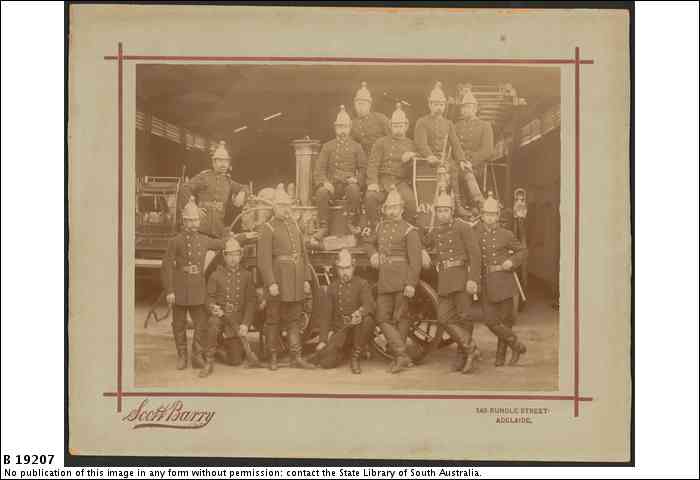 |
|
|
B 19207- Metropolitan Fire Brigade, 1901 |
In 1886 Adelaide did not yet have a steam fire engine.
To get adequate pressure a turncock had to be called in to switch the water off from other users so the fire fighters got the full pressure without other users draining it away. That took 30 to 45 minutes.
The fire brigade was concerned that taller buildings were being built in Adelaide and emphasised the need for new technology:
| If we had a steam-engine we could throw water almost immediately after arrival on any of the buildings in Adelaide - in fact, within eight minutes after leaving our stations, i.e., the time taken up for raising 100 lb. of steam, the quantity required to work the engine. |
John Martin's: April 1901
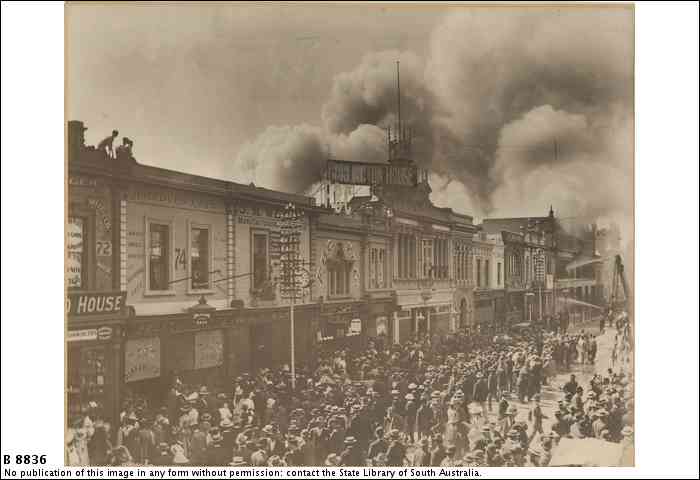 |
|
|
B 8836 - Rundle Street, 1901 |
Mr EW Hayward saw the work of a visiting American window dresser in Melbourne and offered him three months work in Adelaide. 'Rock of Ages' was a design FJ Carr, junior had used across America, and reproduced at John Martins for the Easter season. It showed the figure of a young girl kneeling on a mound with her arms outstretched grasping a cross draped with white muslin.
The windows were lit by gas. The burners were of the only type approved by the insurance companies and a single trusted employee was the only one to light or extinguish them, but on the morning of Saturday 6 April 1901 the glass on one of them cracked and allowed fire to ignite the muslin drapes in the tableau.
As soon as the fire was discovered a staff member borrowed an umbrella and rushed to the signal box in the street, broke the glass and called the brigade. Others closed iron doors separating the two halves of the store.
By this time Adelaide had steam fire engines. The first steamer was there in five minutes, and a second arrived shortly afterwards.
Although the shop was open and filled with shoppers, they and the staff evacuated swiftly. The newspaper report laid emphasis on everyone having to leave so quickly that most had to go outside without their hats and coats.
There was a fair amount of sexist reporting:
| Inside the building, even in the terrible hurry to escape from the fast-spreading blaze, there was no panic. A few of the gentler sex became hysterical, but generally everyone was calm and collected, if hurried. Outside there were scenes of wild excitement. Streams of affrighted assistants, nearly all the girls without hats, alarmed everyone near by. The cry of "fire" spread ... |
The fire began during the day so it was smoke rather than flames that brought people into town to see the spectacle. It was estimated that by noon there were 10,000 people in Rundle Street or North Terrace to view the proceedings.
Firemen worked for hours without relief. The only refreshment was when Mrs. Balfour of Balfours café brought in drinks for the men.
The 1901 John Martin's fire was the largest since the Academy of Music fire of 1886.
City of Singapore: April 1924
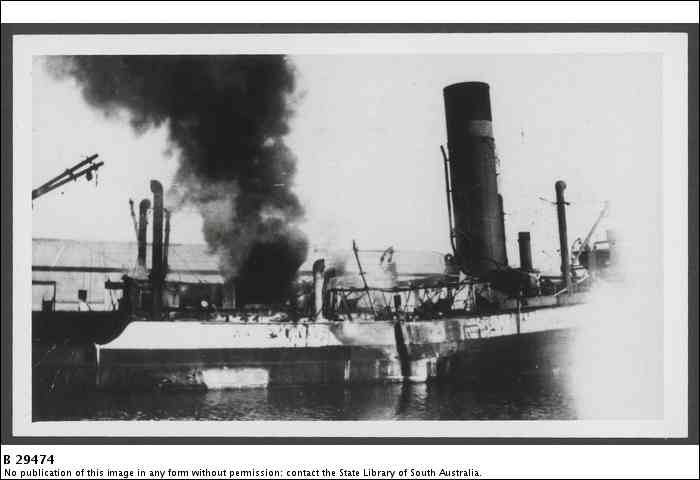 |
||
|
PRG 280/1/40/177 - SS City of Singapore after damage by fire, 1924 |
B 29474 - City of Singapore, 1924 |
The City of Singapore - less than a year old - docked at Port Adelaide in April 1924. Much of its cargo was oil and petrol. In a pre tanker era the fuel was packed in two gallon tins and packed in wooden crates.
Although it had landed fuel at other ports in Australia, and discharged 22 cases of petrol at Port Adelaide there were still 16,000 cases for Fremantle still on board. A fire and explosion caused fatalities and broke the ships back. It took some days for the fire to burn itself out.
Charles Moore's: March 1948
|
|
||
|
B 37809 - Moore's Store Fire, 1948 |
B 21599 - Victoria Square, 1948 |
B 21601 - Victoria Square, 1948 |
The headlines tell the story: 'Big city store destroyed by fire. Moore's burnt to shell in 3 hours. Damage estimated at ₤500,000'.
The fire started in the space between the roof and second-floor ceiling. The shop was protected by sprinklers, but they all pointed down into the shop, leaving the roof space unprotected and the wooden structural timber burned fiercely. The fire started at 6.30 pm on Tuesday 2 March. The location - facing Victoria Square - provided a vantage point for crowds, and it was estimated that the crowd numbered up to 20,000 people.
The shop occupied about an acre. After the fire it was determined that the ground floor was 'perfect' and once the building could be reopened it could start to trade. While reconstruction took place Moores transferred staff to their branches in Kapunda, Perth and Melbourne.
The salvage sale brought big crowds. John Martins hosted the sale. Some of the items make interesting reading - for example 2,000 pairs of womens and children's socks were described as '(damp) 3 pairs for 4/-'.
Covent Garden Restaurant: October 1948
Variously described as a restaurant or café, Covent Garden was a three storey building in King William Street. Flames from a griller on the ground floor ignited fat in the ventilation flues and flames spread quickly to the upper floors.
The manageress ordered diners to leave and they were evacuated without panic. The restaurant employed about 40 people and some kitchen staff were trapped and there were five fatalities. Building regulations had been changed in 1923 after the last major fire in Adelaide, but the need to have fire escapes only applied to new buildings and the café had neither sprinklers nor fire escapes. People were injured when they jumped from upper floors. One man had burns to his hands and arms, but slid down a drainpipe and then caught the tram home. It was only when a neighbour convinced him he needed medical attention and drove him to hospital that his injuries were attended to.
Media debate after the event categorised the resturant as being virually 'a powder magazine'. There was criticism that building regulations were not retrospective and the president of the Trades and Labor Council considered asking unionists to report places they thought were unsafe. The ABC studios - housed in a former church building in Hindmarsh square - was complemented for having installed 'A set of outside escape stairs, recommended and designed by the brigade'.
Another subject of debate was whether there were enough ambulances- there were only eight available at short notice and there should be at least another twelve.
Some other major fires
- Cravens - 1965
- News building - 1968
- People's Palace - 1975
- Centrepoint - formerly Cravens - 1978
- Adelaide and Gay's arcades - 1980
Common themes in reportage
Newspaper reports of major city fires share a number of common themes:
- How the fire started
- Fighting the fire
- Timeline of events
- Description of the devastation
- Human interest stories
- Brief details of the last big fire
- Reforms since last fire
- Changes needed now
Newspaper articles also show how techniques and technology change. The 1886 fire required someone to manipulate water supply valves to provide increased water pressure at the fire scene. By 1901 there were horse drawn steam pumps. The first motor-propelled fire appliance dates from about 1911.
|
B 28395 - Fire brigade, 1880 |
B 3347 - Metropolitan Fire Brigade |
PRG 280/1/12/275 - SA Fire Brigade |
Sources
- Michael F. Page and Malcolm Bryant, Muscle and pluck forever! The South Australian fire services, 1840-1982, [Adelaide], South Australian Metropolitan Fire Service, 1983.
- 'Disastrous fire in Rundle-street. Two men killed. Damage, sixty thousand pounds', Register, 27 December 1886.
- 'The fire in Rundle-street', Register, 27 December 1886.
- Disastrous fire. Premises of John Martin and Co., Ltd, partially destroyed. Between 75,000 -- 80,000 damage', Register, 8 April 1901.
- 'The great fire in Rundle-street', Register, 8 April 1901.
- 'Big steamer on fire at Port Adelaide. An explosion breaks vessel's back. One man killed; two missing. Heavy list of casualties. Deeds of inspiring heroism. Plunge into inferno to the rescue', Advertiser, 20 April 1924.
- 'Big city store destroyed by fire. Moore's burnt to shell in 3 hours. Damage estimated at 500,000', Advertiser, 3 March 1948.
- 'Five die when fire sweeps [Covent Garden] city restaurant. Staff trapped on upper floors. Girls injured as they leap to safety', Advertiser, 28 October 1948.
- 'Disquiet over cafe fire. Questions asked in Parliament', Advertiser, 29 October 1948.
- 'Covent garden "a powder magazine". Adequate escape measures urged by fire chief', Advertiser, 30 October 1948.
- '$2m. blaze in [Gay's and Adelaide]arcades. Difficult to contain, says brigade', Advertiser, 4 August 1980.
- David English and Peter de Ionno, 'Lifelines not used in arcades fire', Advertiser, 5 August 1980.
More Afternoon Delights
ABC Afternoon Delights at the State Library was a series about some of the more unusual items in the State Library. Carole Whitelock talked with Michael Talbot from the State Library in the 2.30 to 3pm timeslot on alternate Tuesdays. View the associated SA Memory page for each topic in the Did you know? section of the website.


